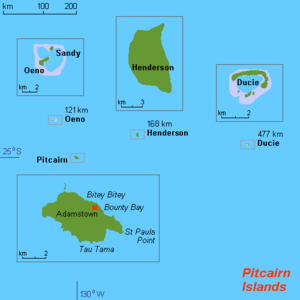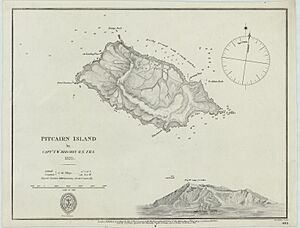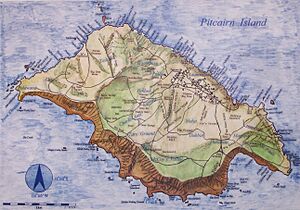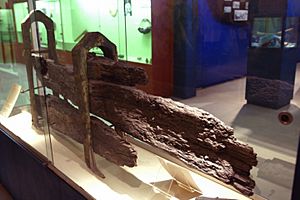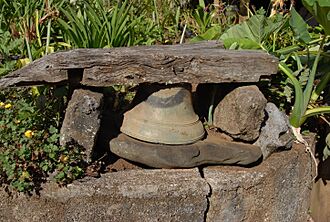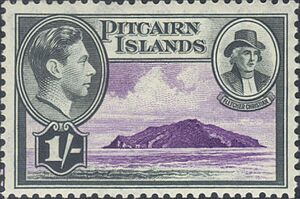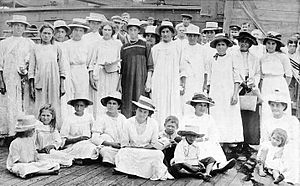History of the Pitcairn Islands facts for kids
The history of the Pitcairn Islands is a fascinating story that began with early settlers and continued with famous sailors. These small islands in the Pacific Ocean have a unique past, from ancient Polynesian explorers to the descendants of the Bounty mutineers.
In the 11th century, Polynesians were the first people to live on the Pitcairn Islands. They built a thriving culture that lasted for about 400 years before disappearing. They lived on Pitcairn and Henderson Islands, as well as on Mangareva Island, which is about 540 km away.
In 1790, nine British sailors from the ship Bounty, led by Fletcher Christian, settled on Pitcairn Island. They were joined by 18 Tahitian men and women. They burned the Bounty ship. Christian's group remained hidden on Pitcairn until 1808. By then, most of the original settlers had died. The remaining women and children were led by John Adams.
Contents
Who Were the First Settlers of Pitcairn?
The earliest known people to settle the Pitcairn Islands were Polynesians. They arrived on Pitcairn and Henderson Islands around the 11th century. They also lived on the larger Mangareva Island, about 540 km to the northwest, for several hundred years.
These early people likely traded with Mangareva. They exchanged things like volcanic rock and oven stones for goods such as coral and pearl shells. Most trading happened within the Pitcairn Islands. However, items from Pitcairn Island have been found in other parts of French Polynesia.
The strong volcanic rock found on Pitcairn Island was used to make high-quality tools called adzes. It is not clear why this Polynesian society disappeared. It might be linked to the cutting down of trees on Mangareva. This led to a decline in their culture. Pitcairn Island could not support many people without trade with other islands. By the mid-1400s, trade routes broke down. Important natural resources ran out, and a civil war started on Mangareva. This caused the small groups on Henderson and Pitcairn to be cut off and eventually die out.
The islands were empty when the Portuguese explorer Pedro Fernandes de Queirós found them in January 1606. The British rediscovered Pitcairn Island on 3 July 1767. This was during a voyage led by Captain Philip Carteret. He named it after Robert Pitcairn, a fifteen-year-old crew member who saw the island first.
When the Bounty mutineers arrived on Pitcairn, no one was living there. However, they found many ancient items. These included stone platforms called marae, tiki carvings, tools, and rock carvings.
Some historians believe the Polynesians who left Pitcairn might have moved to Easter Island. There are similarities between the languages and tools found on these islands. This suggests Pitcairn and Henderson islands might have been stopping points on the way to Easter Island. In 1999, a voyage using traditional Polynesian boats reached Easter Island from Mangareva in just over 17 days.
The Mutineers Arrive: British and Tahitian Settlement
After leaving Tahiti on 22 September 1789, Fletcher Christian sailed the Bounty to find a safe place. He decided to settle on Pitcairn Island. The island had been reported in 1767, but its exact location was not known. Christian found the island on 15 January 1790. It was about 348 km east of where it was supposed to be. This mistake in location helped the mutineers decide to settle there, as it made them harder to find.
The group included nine British sailors and six Polynesian men. There were also twelve Tahitian women and a Tahitian baby girl.
When they arrived, they unloaded the ship. On 23 January, five days later, the ship was set on fire and destroyed. This meant there was no way for them to leave the island.
Pitcairn Island was a perfect hiding place. It was empty and hard to reach. It had plenty of food, water, and good land. For a while, the mutineers and Tahitians lived together peacefully. Christian had a son, Thursday October Christian I, who was the first child born on the island. More children followed. Christian's power as a leader slowly faded.
Early Challenges and New Leadership
Over time, problems arose between the Europeans and the Tahitians. Some of the European men treated the Tahitian men unfairly. This caused tension and anger.
On 20 September 1793, the remaining Polynesian men took guns. They attacked and killed four of the Englishmen. Fletcher Christian was also badly wounded and died.
Ned Young and John Adams then took charge. They became interested in Christianity. Young taught Adams to read using the Bountys Bible. Young died in 1800 from an asthma attack. Adams lived until 1829.
How Was Contact Reestablished with the Outside World?
After Young died in 1800, Adams became responsible for the nine women and 19 children. He used the ship's Bible to teach them to read and about Christianity. He also helped keep peace on the island.
In February 1808, an American sealing ship called Topaz found Pitcairn by accident. The captain, Mayhew Folger, landed and discovered the growing community. News of this discovery reached Britain in 1810. However, the British navy was busy with a war and did not pay much attention.
In 1814, two British warships, HMS Briton and HMS Tagus, also found Pitcairn. Among those who greeted them were Thursday October Christian and George Young. The captains reported that Christian's son looked like "an honest English face." On shore, they found 46 islanders, mostly young people, led by Adams. The British navy decided not to take any action.
Other nearby islands were also discovered. Henderson Island was found again in 1819. Oeno Island was discovered in 1824.
Many ships visited Pitcairn Island in the following years. Adams told them different stories about how the settlement began. Adams died in 1829. He was honored as the founder and father of a community that became famous for its good behavior. Over the years, islanders sold many items from the Bounty as souvenirs.
During the 1820s, three British adventurers named John Buffett, John Evans, and George Nobbs settled on the island. They married children of the mutineers. After Adams died in 1829, there was no clear leader. Nobbs was Adams's chosen successor. However, Buffett and Thursday October Christian I, Fletcher Christian's son, were also important leaders.
Why Did Pitcairners Move to Tahiti and Return?
The islanders became worried about overcrowding on Pitcairn. They asked the British government to move them to Tahiti. In 1831, the British government moved them there.
But Tahiti was not what they remembered. They found it full of "immorality" and bad influences. The descendants of the mutineers could not get used to the changes in Tahiti. A dozen people, including Thursday October Christian, died from disease. The islanders felt even more lost without strong leaders. After six months, they returned to Pitcairn on a ship.
New Leaders and Voting Rights
In 1832, an adventurer named Joshua Hill arrived. He claimed to be a British agent and was elected leader. He called himself the President of the Commonwealth of Pitcairn. He sent Buffett, Evans, and Nobbs away from the island. He also ordered punishments for small mistakes. He was eventually forced to leave the island in 1838.
A British ship captain then helped the islanders create a set of laws. The islanders decided to elect a chief magistrate every year to lead the island.
Other important jobs on the island were schoolmaster, doctor, and pastor. Nobbs became the main leader of the island. Under these new laws, Pitcairn became the first British colony in the Pacific. It was also the second place in the world, after Corsica in 1755, to give women the right to vote.
Pitcairn Becomes a British Colony
Pitcairn Islanders believe their islands officially became a British colony on 30 November 1838. At the same time, it became one of the first places to give women the right to vote.
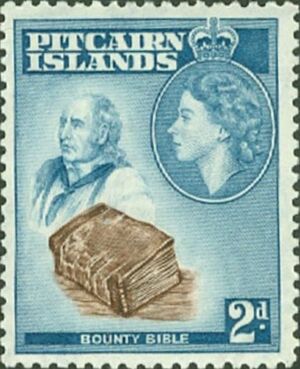
Why Did Pitcairners Move to Norfolk Island?
By the mid-1850s, the Pitcairn community was getting too big for the island. They asked Queen Victoria for help. Queen Victoria offered them Norfolk Island. In 1856, all 163 residents traveled across the Pacific to Norfolk Island. This island used to be a prison colony. They arrived on 8 June after a difficult five-week trip.
Eighteen months later, sixteen people returned to Pitcairn. Another 27 followed in 1864.
In 1858, while Pitcairn was empty, survivors of a shipwreck lived there for several months. They took wood and nails from some houses. They also damaged John Adams' grave. The island was almost taken over by France, who did not know it had just been lived on.
During the 1860s, more people were not allowed to move to Pitcairn. In 1886, a Seventh-day Adventist named John Tay visited Pitcairn. He convinced most of the islanders to change their religion from the Church of England to his faith. He returned in 1890 with a minister to perform baptisms. Since then, most Pitcairn Islanders have been Adventists.
Important leaders during this time included Thursday October Christian II, Simon Young, and James Russell McCoy. In 1887, Britain officially took control of the island. It was placed under the authority of the governors of Fiji.
Pitcairn in the 20th Century
The islands of Henderson, Oeno, and Ducie were officially taken over by Britain in 1902. Henderson on 1 July, Oeno on 10 July, and Ducie on 19 December. The population of Pitcairn reached its highest point in 1937, with 233 people. Since then, the population has decreased as people moved away, mostly to Australia and New Zealand.
In 1938, the three islands, along with Pitcairn, were combined into one administrative area called the Pitcairn Group of Islands. By the 1930s and 1940s, fewer ships visited the island. This meant less tourism. Residents sold many old cultural items and Bounty-related things to earn money. In 1940 and 1941, the British government sent Henry Evans Maude and his wife to the islands. They helped modernize the government. They also set up a post office and started issuing stamps to create income for the people.
Pitcairn's Current Society
In the 20th century, most of the chief magistrates came from the Christian and Young families. Contact with the outside world continued to grow. In 1970, the British high commissioners of New Zealand became the governors of Pitcairn. Since August 2022, the governor has been Iona Thomas. In 1999, the role of chief magistrate was changed to mayor. Another change for the community is the decline of the Adventist church, with only a few regular worshippers now.
The population reached 233 in 1937. Since then, many people have moved away, mainly to New Zealand. As of 2021, the population is 47. The islands depend a lot on tourism and fees from ships visiting for their income. They also receive shipments from New Zealand.
Who Was the First Female Mayor?
Charlene Warren-Peu (born 9 June 1979) was elected Mayor of the Pitcairn Islands in 2019. She is the first woman to hold this position permanently. Before becoming mayor, she served as Deputy Mayor and was on the Island Council.
See also
 In Spanish: Historia de las Islas Pitcairn para niños
In Spanish: Historia de las Islas Pitcairn para niños


